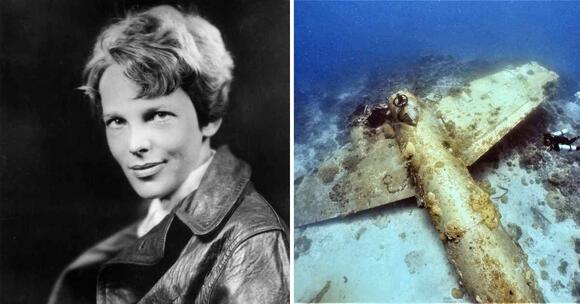After nearly nine decades of silence, the world’s most haunting aviation mystery may finally be solved. A drone exploring a remote lagoon in the Pacific has discovered what experts are calling “irrefutable proof” of Amelia Earhart’s long-lost Lockheed Electra 10E — the aircraft she vanished in during her fateful 1937 attempt to fly around the world.

For 87 years, countless theories, expeditions, and rumors have surrounded Earhart’s disappearance. Some claimed she crashed at sea, others insisted she was captured by foreign forces, and a few whispered she lived out her days in secret. But now, new drone footage has revealed an angular, metallic object buried beneath layers of sediment in a lagoon on Nikumoro Island — an object that has been visible in aerial photos dating back to 1938, just one year after her disappearance.
Dubbed the “Teria Object,” this strange structure matches the shape and size of Earhart’s aircraft. And here’s the bombshell: experts say it’s been there all along — hiding in plain sight. Historical imagery shows the same outline in decade after decade of satellite data, ignored simply because search teams were looking in the wrong place — the reef and the shoreline — never beneath the lagoon’s surface.
The discovery comes from a joint research team from Purdue University (Earhart’s alma mater) and the Archaeological Legacy Institute. These experts are now on an urgent mission to reach Nikumoro Island, equipped with high-resolution drones, underwater magnetometers, and sidescan sonar to confirm the find. Their one-week expedition, beginning October 30, 2025, could finally reveal what the world has been waiting for — the resting place of Amelia Earhart and her navigator Fred Noonan.
But that’s not all. Forensic analyses of skeletal remains previously found on Nikumoro indicate a 99% probability that they belonged to a European woman matching Earhart’s height and build. Alongside those remains, researchers uncovered a woman’s shoe, aircraft aluminum fragments, and tools consistent with Earhart’s equipment — forming a mosaic of evidence too powerful to ignore.
Skeptics have long dismissed such claims, but this time, experts insist the case is different. “The evidence is overwhelming,” one researcher said. “This isn’t speculation anymore — it’s history catching up to the truth.”
The implications are monumental. If confirmed, this would not only solve one of the greatest mysteries in aviation history, but also bring closure to a story that has haunted the world for generations. For Purdue University, which funded Earhart’s original Electra, the discovery would be the fulfillment of a promise — to bring their pioneering alumna home.
As the world waits in breathless anticipation, one question echoes across time:
👉 Could this finally be it? Could Amelia Earhart’s legendary flight, which vanished into myth in 1937, at last be found in a quiet Pacific lagoon — waiting to tell her story?
In the coming weeks, we may witness the moment history takes a deep breath… and whispers the truth it has kept for 87 years. ✈️🌊






